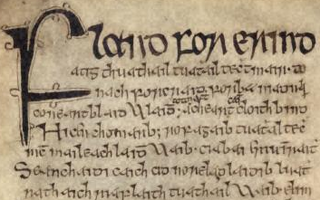Related Research Articles

The Annals of the Kingdom of Ireland or the Annals of the Four Masters are chronicles of medieval Irish history. The entries span from the Deluge, dated as 2,242 years after creation to AD 1616.
Toirdhealbhach ua Briain, anglicised Turlough O'Brien, was King of Munster and effectively High King of Ireland. A grandson of Brian Bóruma, Toirdelbach was the son of Tadc mac Briain who was killed in 1023 by his half-brother Donnchad mac Briain.
Gormlaith ingen Murchada (960–1030), sometimes spelt Gormflaith, was an Irish queen.
Erc was king of Irish Dál Riata from 439 until 474, succeeding Eochaid Muinremuir. He was the father of three sons: Fergus Mór, Loarn and Oengus. He also may have been the great-grandfather of Muirchertach mac Muiredaig. Confusion arises from the latter's matronym, Macc Ercae, said to come from his legendary mother Erc ingen Loarn, daughter of Loarn mac Eirc. She married Muiredach mac Eógain. According to the Duan Albanach and the Senchus Fer n-Alban, Erc of Dál Riata's father was Eochaid Muinremuir, son of Áengus Fert, son of Fedlimid, son of Oengus, son of another Fedlimid, son of Senchormaich, son of Cruitlinde, son of Findfece, son of Archircir, son of Eochaid Antoit, son of Fiacha Cathmail, son of Cairbre Riata, son of Conaire Cóem and Saraid ingen Chuinn.
Sigtrygg II Silkbeard Olafsson was a Hiberno-Norse king of Dublin of the Uí Ímair dynasty. He was caught up in the abortive Leinster revolt of 999–1000, after which he was forced to submit to the King of Munster, Brian Boru. His family also conducted a double-marriage alliance with Boru, although he later realigned himself with the main leaders of the Leinster revolt of 1012–1014. He has a prominent role in the 12th-century Irish medieval text Cogadh Gaedhil re Gallaibh and the 13th-century Icelandic Njal's Saga, as the main Norse leader at the Battle of Clontarf (1014).
Cerball mac Muirecáin was king of Leinster. He was the son of Muirecán mac Diarmata and a member of the Uí Fáeláin, the descendants of Fáelán mac Murchado, of one of three septs of the Uí Dúnlainge of modern County Kildare in Ireland.

The Uí Ímair, also known as the Ivardynasty or Ivarids, was a Norse-Gael dynasty which ruled much of the Irish Sea region, the Kingdom of Dublin, the western coast of Scotland, including the Hebrides and some part of Northern England, from the mid 9th century.

Flann mac Máel Sechnaill, better known as Flann Sinna, was the son of Máel Sechnaill mac Máele Ruanaid of Clann Cholmáin, the leading branch of the Southern Uí Néill. He was King of Mide from 877 onwards and a High King of Ireland. His mother Land ingen Dúngaile was a sister of Cerball mac Dúnlainge, King of Osraige.

Máel Sechnaill mac Domnaill, also called Máel Sechnaill Mór or Máel Sechnaill II, was a King of Mide and High King of Ireland. His great victory at the Battle of Tara against Olaf Cuaran in 980 resulted in Gaelic Irish control of the Kingdom of Dublin.
Augaire mac Ailella was the King of Laigin (Leinster), Ireland, who is said to have led the Irish forces at the Battle of Confey c. 915-917. The Irish were defeated by Vikings under King Sigtrygg Caech from Dublin. The Annals of the Four Masters said he was killed in the battle. The warrior who actually slew Ugaire in 917 was the father of Palnatoke, who in the Jómsvíkinga saga is named Palner Tokesen.
Donnchad Donn mac Flainn was High King of Ireland and King of Mide. He belonged to Clann Cholmáin, a branch of the southern Uí Néill.
Ivar of Limerick, was the last Norse king of the city-state of Limerick, and penultimate King of the Foreigners of Munster, reigning during the rise to power of the Dál gCais and the fall of the Eóganachta.
Áed Ua Ruairc, also known as Áed mac Art Uallach Ua Ruairc, was the King of Connacht from 1067 to 1087. He became king after killing the previous King of Connacht, Áed in Gai Bernaig, in battle in 1067.
Art Uallach Ua Ruairc was King of Connacht.
Caitilin Dubh, Irish poet, fl. c. 1624.
Dubhchobhlaigh or Dubh Cobhlaigh is an Irish language feminine given name.
Uallach is an Irish language female given name.
Máel Muire was Queen of Ireland, being actually styled so in the Annals of Clonmacnoise. The wife of Máel Sechnaill mac Domnaill, High King of Ireland, she was a daughter of Amlaíb Cuarán, King of Dublin until 980/1 and formerly King of York. Thus she was a member of the Norse-Irish Uí Ímair dynasty and the first Queen of Ireland of ultimately foreign or non-Gaelic lineage known to be historical. One of her brothers was the celebrated King of Dublin Sitric Silkbeard, while a sister Gytha was wife to Olaf Tryggvason, King of Norway.
Cacht ingen Ragnaill was the queen of Donnchad mac Briain, from their marriage in 1032 to her death in 1054, when she is styled Queen of Ireland in the Irish annals of the Clonmacnoise group: the Annals of Tigernach and Chronicon Scotorum. Her husband himself, though King of Munster, is not widely regarded as having been High King of Ireland and so the extent of Cacht's influence is uncertain. That her style is superior to his presents an obviously strange situation in medieval Gaelic Ireland's male-dominated politics.
Events from the year 1637 in Ireland.
References
- Uallach ingen Muinechain, Maire Ni Dhonnchadha, in The Encyclopaedia of Ireland, p. 1087, Dublin, 2003.